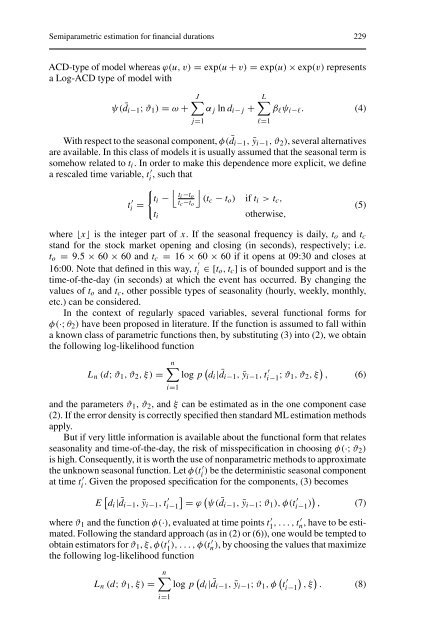recent developments in high frequency financial ... - Index of
recent developments in high frequency financial ... - Index of
recent developments in high frequency financial ... - Index of
You also want an ePaper? Increase the reach of your titles
YUMPU automatically turns print PDFs into web optimized ePapers that Google loves.
Semiparametric estimation for f<strong>in</strong>ancial durations 229<br />
ACD-type <strong>of</strong> model whereas ϕ(u, v) = exp(u + v) = exp(u) × exp(v) represents<br />
a Log-ACD type <strong>of</strong> model with<br />
ψ(¯di−1; ϑ1) = ω +<br />
J�<br />
αj ln di−j +<br />
j=1<br />
L�<br />
βℓψi−ℓ. (4)<br />
With respect to the seasonal component, φ(¯di−1, ¯yi−1,ϑ2), several alternatives<br />
are available. In this class <strong>of</strong> models it is usually assumed that the seasonal term is<br />
somehow related to ti. In order to make this dependence more explicit, we def<strong>in</strong>e<br />
a rescaled time variable, t ′ i , such that<br />
t ′ i =<br />
�<br />
ti −<br />
ti<br />
� ti−to<br />
tc−to<br />
ℓ=1<br />
�<br />
(tc − to) if ti >tc,<br />
otherwise,<br />
where ⌊x⌋ is the <strong>in</strong>teger part <strong>of</strong> x. If the seasonal <strong>frequency</strong> is daily, to and tc<br />
stand for the stock market open<strong>in</strong>g and clos<strong>in</strong>g (<strong>in</strong> seconds), respectively; i.e.<br />
to = 9.5 × 60 × 60 and tc = 16 × 60 × 60 if it opens at 09:30 and closes at<br />
16:00. Note that def<strong>in</strong>ed <strong>in</strong> this way, t ′<br />
i ∈[to,tc] is <strong>of</strong> bounded support and is the<br />
time-<strong>of</strong>-the-day (<strong>in</strong> seconds) at which the event has occurred. By chang<strong>in</strong>g the<br />
values <strong>of</strong> to and tc, other possible types <strong>of</strong> seasonality (hourly, weekly, monthly,<br />
etc.) can be considered.<br />
In the context <strong>of</strong> regularly spaced variables, several functional forms for<br />
φ(·; θ2) have been proposed <strong>in</strong> literature. If the function is assumed to fall with<strong>in</strong><br />
a known class <strong>of</strong> parametric functions then, by substitut<strong>in</strong>g (3) <strong>in</strong>to (2), we obta<strong>in</strong><br />
the follow<strong>in</strong>g log-likelihood function<br />
Ln (d; ϑ1,ϑ2,ξ) =<br />
(5)<br />
n�<br />
log p � di| ¯di−1, ¯yi−1,t ′ i−1 ; ϑ1,ϑ2,ξ � , (6)<br />
i=1<br />
and the parameters ϑ1, ϑ2, and ξ can be estimated as <strong>in</strong> the one component case<br />
(2). If the error density is correctly specified then standard ML estimation methods<br />
apply.<br />
But if very little <strong>in</strong>formation is available about the functional form that relates<br />
seasonality and time-<strong>of</strong>-the-day, the risk <strong>of</strong> misspecification <strong>in</strong> choos<strong>in</strong>g φ(·; ϑ2)<br />
is <strong>high</strong>. Consequently, it is worth the use <strong>of</strong> nonparametric methods to approximate<br />
the unknown seasonal function. Let φ(t ′ i ) be the determ<strong>in</strong>istic seasonal component<br />
at time t ′ i . Given the proposed specification for the components, (3) becomes<br />
� �<br />
= ϕ ψ(¯di−1, ¯yi−1; ϑ1), φ(t ′ i−1 )� , (7)<br />
E � di| ¯di−1, ¯yi−1,t ′ i−1<br />
where ϑ1 and the function φ(·), evaluated at time po<strong>in</strong>ts t ′ 1 ,...,t′ n , have to be esti-<br />
mated. Follow<strong>in</strong>g the standard approach (as <strong>in</strong> (2) or (6)), one would be tempted to<br />
obta<strong>in</strong> estimators for ϑ1, ξ, φ(t ′ 1 ),...,φ(t′ n ), by choos<strong>in</strong>g the values that maximize<br />
the follow<strong>in</strong>g log-likelihood function<br />
Ln (d; ϑ1,ξ) =<br />
n�<br />
i=1<br />
log p � di| ¯di−1, ¯yi−1; ϑ1,φ � t ′ � �<br />
i−1 ,ξ . (8)










